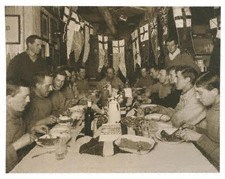The Octavius Popebury Memorial Expedition of 1886
The Octavius Popebury Memorial Expedition of 1886 was one of the last great acts of the Age of Exploration and inspired over thirty moving pictures and several hundred monographs. It has become a byword for bravery, sexism, patriotism, blind stupidity, casual racism, communism, facism and bloody minded stubborness. For their sterling work, every gentleman involved was posthumously inducted into the Ancient Order of Jolly Good Eggs for their work on behalf of king, class and country. Over thirteen hundred monuments have been erected in their memory. Every May 16th, the small town of Berswickbottom celebrates Octavius Popebury Day and a parade is traditionally organised to commemorate these upstanding examples of manhood. But who were these gallant men and how did they earn their place in the leather-bound, gilt-inscribed, multi-volume history books?
Contents
Background
Octavius Popebury, an Irish peer, was the founding member of the League of Respectable Gentlemen. A noted explorer, his discoveries included the islands of Old New Brunswick and Terra Muerte. He has been credited with the discovery of the source of the Rotte and Xinhyei rivers. When rumours of a place known as Shartak reached the League, he began to organise an expedition. Tragically, he was beaten by a mob of urchins and died a week before departure. After taking their colective belts to the wretched scamps, the League pledged to continue his work as a way of showing respect to the man they knew affectionately as Sir Octavius Popebury, Esq.
The Journey
The Octavius Popebury Memorial Expedition departed the port of Sife-on-Thee in March 1884. They landed several miles down the coast in August 1885 where they claimed the village of Faffesbury in the name of the King. After brisk skirmishing with the natives, they pacified the region and established a trading post. The King commended their vigour but recalled the expedition. A second ship, the Proper Sort, departed Sife-on-Thee in September 1885, which arrived in the southern waters off Shartak in May 1886. It was wrecked near Derby during an unseasonably heavy storm. But the expedition made landfall and was considered a restounding success, despite the loss of all of their horses, port, stores and servants. The gentlemen immediately began walking briskly for Derby.
The Members
Lord Twerpington
Lord Quentin Twerpington, 11th Earl of Stonyford, married with seven children, £13,000 a year, served in the Second Krimean War commanding the 1st Stonyford Rifles, present at the battle of Heifer's Pass, lost his pocket watch and half the regiment during the attack on the Palace of the Veiled Sultan, credited with the discovery of Denmark.
Commodore Ecclington
Commodore Sir Sebastian Gabriel Ecclington, 1st Earl of New Stratbury, Married with five children, £11,000 a year plus toll rights on the New Stratsbury Straits, Served in the Royal Navy for 21 years, never lost his hat to the sea.
Sir Tuppenny
Sir George Tuppenny, suffered loss of memory on his arrival to the island. Alleged to have been the 23rd heir to the throne, according to parts of his diary that he managed to keep. It was because of this royal blood that the expedition leaders are believed to have ignored both his amnesia and mild dementia, but also due to his proven loyalty.
Lord Fortescue-Smyth
Lord Algernon Fortescue-Smyth, 18th Squire of Middleframpshire and 29th Earl of Darlington, married with six children, £12,120 14/3 ¾d a year, served in the Napoleonic Wars with the 27th Flying Belchshires as a messenger boy, present at the Siege of Dupal and witnessed the Fall of the Quenzhautatzal Empire, blunderbuss stolen by blasted natives while tiger hunting in India and used as a heathen effigy in a ritual sacrifice - hasn't worked properly since bygawds, credited with inventing flypaper.
Major Chapsley
Major William Chapsley, 2nd Baron of Yorth-on-Twang, Married with 7 sons, £12,000 a year, served in the First Maraka War commanding the King's Own Light Infantry, held the Fort of Kookamunga against assault during the Second Maraka War, credited with the development of the Chapsley Method of discipline.


